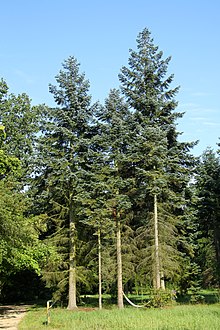Abies procera
| Abies procera | |
|---|---|
 | |
| Scientific classification | |
| Kingdom: | Plantae |
| Clade: | Tracheophytes |
| Clade: | Gymnospermae |
| Division: | Pinophyta |
| Class: | Pinopsida |
| Order: | Pinales |
| Family: | Pinaceae |
| Genus: | Abies |
| Species: | A. procera |
| Binomial name | |
| Abies procera | |
 | |
| Natural range | |
| Synonyms[2] | |
| |
Abies procera, the noble fir, also called red fir and Christmas tree,[3] is a species of fir native to the Cascade Range and Pacific Coast Ranges of the northwestern Pacific Coast of the United States. It occurs at altitudes of 300–1,500 meters (980–4,920 ft).
Description
[edit]A. procera is a large evergreen conifer with a narrow conic crown, growing up to 70 meters (230 ft) tall and 2 m (6 ft 7 in) in trunk diameter, rarely to 90 m (295 ft) tall and 2.7 m (8 ft 10 in) thick.[4] The bark on young trees is smooth and gray with resin blisters, becoming red-brown, rough and fissured on old trees, usually less than 5 centimeters (2 in) thick; the inner bark is reddish.[5] The leaves are needle-like, 1–3.5 cm (1⁄2–1+1⁄2 in) long, glaucous blue-green above and below with strong stomal bands, and a blunt to notched tip. They are arranged spirally on the shoot, but twisted slightly S-shaped to be upcurved above the shoot. The cones are erect, 11–22 cm (4+1⁄4–8+3⁄4 in) long and 6 cm (2+1⁄4 in) thick, with the purple scales almost completely hidden by the long exserted yellow-green bract scales;[5] they ripen brown and disintegrate to release the winged seeds in fall. Viable seeds are only produced every few years.[5]
The species can grow for up to 200 years.[5]
Taxonomy
[edit]David Douglas discovered the species in the Cascade Range in the early 19th century, calling it the "noble fir".[5]
The specific epithet procera means "tall".[6] It is the world's tallest true fir.[5]
Distribution
[edit]The species is native to the Cascade Range and Pacific Coast Ranges of western Washington and Oregon, as well as the extreme northwest of California. It is a high-altitude tree, typically occurring at altitudes of 300–1,500 m (980–4,920 ft), often above 600 m (2,000 ft),[5] and only rarely reaching the tree line.
Ecology
[edit]The species is very closely related to Abies magnifica (red fir), which replaces it farther southeast in southernmost Oregon and California, being best distinguished by the leaves having a groove along the midrib on the upper side; red fir does not show this. Red fir also tends to have the leaves less closely packed, with the shoot bark visible between the leaves, whereas the shoot is largely hidden in noble fir. Red fir cones also mostly have shorter bracts, except in A. magnifica var. shastensis (Shasta red fir); this variety hybridizes with noble fir[5] and may itself be a hybrid between noble fir and red fir. As opposed to Shasta red fir, noble fir is shade-intolerant, leaving its lower trunk branchless.[5]
Noble fir occurs with Douglas-fir and western hemlock at middle elevations, and with Pacific silver fir and mountain hemlock at higher elevations.[5] It occurs in cool, humid areas similar to those occupied by Pacific silver fir.[5] While it benefits from occasional disturbances (e.g. the 1980 eruption of Mount St. Helens), it is very susceptible to fire but is usually protected by its moist environment.[5] It is relatively resistant to damage from wind, insects or diseases.[5] Although the roots grow slowly, it can survive in very rocky soil as long as it is moist.[5]
Uses
[edit]The Paiute used the foliage to treat coughs and colds.[5]
The superior light and strong wood was recognized early by loggers, who called it "larch" to avoid conflating it with inferior firs.[5] The wood is used for specialized applications such as ladders,[5] general structural purposes and paper manufacture. It may have been used for the frames of the Royal Air Force's Mosquito bombers during World War II.[5]
David Douglas sent noble fir seeds to Britain in 1830, introducing it to horticulturalists.[5] It is a popular and favored Christmas tree.[5] The prostrate grey cultivar A. procera (Glauca Group) 'Glauca Prostrata' has gained the Royal Horticultural Society's Award of Garden Merit.[7][8]
- Cone
- Cones
- Foliage
References
[edit]- ^ Farjon, A. (2013). "Abies procera". IUCN Red List of Threatened Species. 2013: e.T42296A2970458. doi:10.2305/IUCN.UK.2013-1.RLTS.T42296A2970458.en. Retrieved 12 November 2021.
- ^ "The Plant List: A Working List of all Plant Species".
- ^ "Abies procera". Germplasm Resources Information Network. Agricultural Research Service, United States Department of Agriculture. Retrieved 17 December 2017.
- ^ "Gymnosperm Database - Abies procera". Retrieved 2013-09-06.
- ^ a b c d e f g h i j k l m n o p q r s t Arno, Stephen F.; Hammerly, Ramona P. (2020) [1977]. Northwest Trees: Identifying & Understanding the Region's Native Trees (field guide ed.). Seattle: Mountaineers Books. pp. 143–149. ISBN 978-1-68051-329-5. OCLC 1141235469.
- ^ Harrison, Lorraine (2012). RHS Latin for Gardeners. United Kingdom: Mitchell Beazley. ISBN 978-1845337315.
- ^ "Abies procera (Glauca Group) 'Glauca Prostrata'". RHS. Retrieved 14 August 2019.
- ^ "AGM Plants - Ornamental" (PDF). Royal Horticultural Society. July 2017. p. 1. Retrieved 14 August 2019.
Further reading
[edit]- Farjon, A. (2013). "Abies procera". IUCN Red List of Threatened Species. 2013: e.T42296A2970458. doi:10.2305/IUCN.UK.2013-1.RLTS.T42296A2970458.en. Retrieved 12 November 2021.
External links
[edit]- USDA Plants Profile for Abies procera (noble fir)
- Interactive Distribution Map of Abies procera
- Abies procera—Gymnosperm Database
- Jepson Manual Treatment: Abies procera
- photos of Abies procera trees—Arboretum de Villardebelle
- photos of foliage and cones—Arboretum de Villardebelle
- Abies procera—U.C. Photo gallery


 French
French Deutsch
Deutsch


